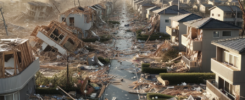In today’s world, emergencies can strike at any moment. From natural disasters like hurricanes, floods, and wildfires to man-made catastrophes such as chemical spills, terrorist attacks, or serious home fires, these situations can force families to evacuate their homes with little to no notice. Preparing for such events before they occur can be the difference between chaos and safety. This article provides essential tips on crafting a comprehensive family evacuation strategy to ensure your family’s safety during these stressful times.
Planning for the Unthinkable: Creating a Family Evacuation Strategy
First and foremost, communication is key in any emergency situation. Ensure every family member, including children, understands what an evacuation is, why it might be necessary, and how it will be carried out. Explain the types of disasters that might trigger an evacuation and consider discussing news stories about real-life evacuations to help illustrate the point.
Next, identify two meeting places—one near your home for sudden emergencies, such as a fire, and another outside your neighborhood in case you can’t return home. Ensure all family members know the locations and how to reach them.
Another critical step is to identify and organize important documents, such as passports, birth certificates, and insurance policies. Keep these documents in a secure, easily accessible, and portable container in case you need to evacuate quickly.
Lastly, consider the unique needs of your family. Does anyone require special medical equipment or medication? Do you have pets to consider? Make sure your evacuation plan takes into account all of these elements.
Essential Tips for Crafting a Comprehensive Evacuation Plan
Your evacuation plan should be clear, straightforward, and easy to execute under stress. Start by mapping out the quickest and safest routes out of your home and neighborhood. Have multiple routes in case one is blocked or unsafe.
Keep an emergency kit stocked with food, water, first aid supplies, flashlights, batteries, necessary medicines, clothing, cash, and any other critical items. Make sure this kit is easy to carry and readily accessible.
Stay informed and follow guidance from local authorities during an evacuation. They will provide important updates and instructions.
Lastly, establish a contact outside your immediate area that can assist in communicating between separated family members. During widespread disasters, it can often be easier to make a long-distance call than a local one.
Practicing Your Comprehensive Evacuation Plan
Practicing your evacuation plan is crucial to ensure everyone knows what to do when an emergency strikes. Regularly run drills imagining different scenarios that would require evacuation.
For children, make these practices a game to make them less scary but also to ensure they take them seriously. Reinforce the importance of staying calm and following the plan.
During practices, test your emergency kit as well. Check the expiration dates on food and medical supplies, test batteries and devices, and replace any outdated or used items.
Finally, after each drill, review and revise your plan as needed based on any issues or delays that arose during the practice. Regularly updating and practicing your plan will ensure its effectiveness during a real evacuation.
While it’s never pleasant to contemplate the likelihood of having to evacuate your home due to a disaster, having a comprehensive evacuation plan can be a lifesaver. By planning ahead, you can ensure that each family member understands their role in an evacuation, knows where to go, and can do so quickly and safely. Remember, the key to a successful evacuation is not just crafting the plan, but regular practice and revision. Your family’s safety may depend on it.


